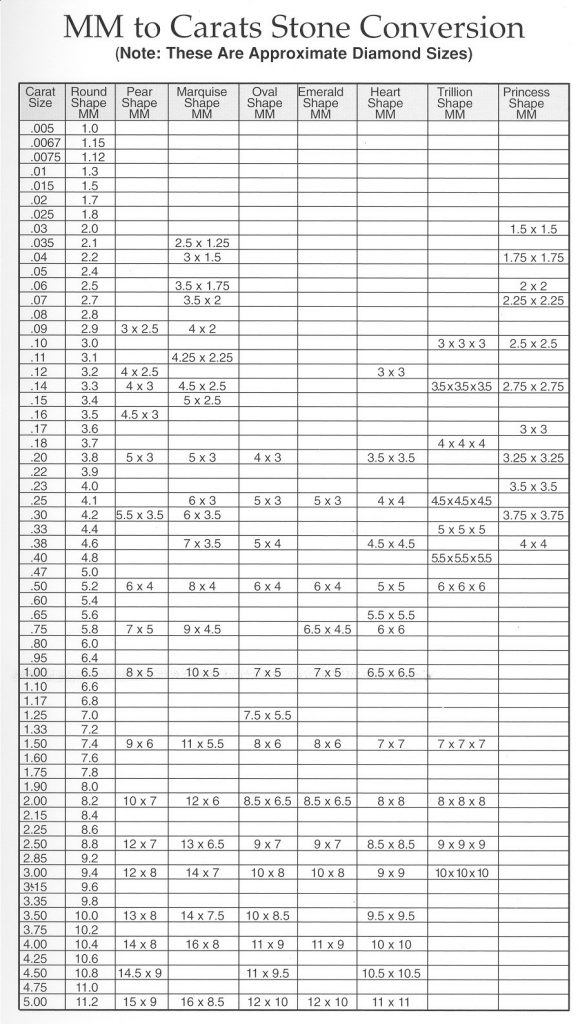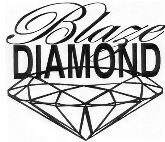Carat Weight

Weight Conversions and Information
Carat Weight
Used in weighing precious and semi-precious stones. (note: the term “Karat” refers to the quality of purity in gold.)
1 carat = 31/16 grains Troy
1 carat = .007 ounce Acoir
1 carat = 1/5 gram
The carat is further divided into points for simple measurement:
1 carat = 100 points
½ carat = 50 points
¼ carat = 25 points
Carats to Millimeters (Diameter) Conversion Chart for RoundDiamonds
Example: A diamond with a 6.5mm diameter will weigh appx. 1.00-ct (assuming it is cut to correct proportions)
More Interesting & Neat Information
Additional Information
Troy Weight
Used in weighing precious metals.
24 grains = 1 pennyweight (dwt.)
20 dwt = 1 ounce Troy
12 ounces = 1 pound Troy
5760 grains = 1 pound Troy
480 grains = 1 Troy oz.
1 kilogram = 2.68 pounds
1 kilogram = 32.15 Troy oz.
1 kilogram = 2.2046 lbs. Avoir
1 kilogram = 35.2740 oz. Avoir
1 kilogram = 15,432 grains
Troy oz. = 1.0972 Avoir oz.
Avoirdupois Weight
Used in weighing base metals.
16 drams (or drachms) = 1 oz. Avoir
16 ounces = 1 pound Avoir
16 ounces = 7,000 grains
28 pounds = 1 quarter English
4 quarters = 1 hundredweight (cwt.)
20 hundredweight = 1 ton Avoir
1 pound Avoir = 14.5833 Troy oz.
1 ounce Avoir = 0.914 Troy oz.
1 pound Avoir = 7,000 grains
1 ounce Avoir = 437.5 grains
1 pound Avoir = .4359 kilo.
Gram Weight
1 gram = 15.43 grains Troy
1.555 grams = 1 pennyweight (dwt.)
31.104 grams = 1 ounce Troy
28.35 grams = 1 ounce Avoir
1 grain = 0.0648 grams
1 grain = 64.80 milligrams
1 milligram = .015432 grams
1 gram = .035274 Avoir oz.
1 gram = .032151 Troy oz.
Karat Gold Information
Pure gold (fine gold) is softer than pure silver. Its beauty and luster are unmatched by any alloyed golds. The extreme malleability, ductility, and softness of pure gold make it unique.
The addition of alloying elements (other metals) to gold are used to increase the toughness and hardness of the metal. While almost any metal can be alloyed (melted) with gold, only certain metals will not dramatically change the color or make the metal brittle. The addition of indium, for instance, turns gold purple and gives gold the workability of glass.
The percentages of gold have become legally recognized “karats.” The karat indicates the amount of gold as a percentage of the total, i.e. 24 karat is 100 percent gold. Thus 14 karat is 14/24’s gold or 58-1/3 percent gold. Gold standards vary around the world. In the United States, 18, 14, and 10 karat gold are the only karats allowed to be sold as karated gold.
In karated gold, there is a balance of metals in the non-gold percentage. These metals provide the various colorsand hardness of karated golds. Typical alloying elements and their color effect are:
Copper – Reddening
Silver – Greening
Zinc – Bleaching
Nickel – Whitening
Palladium – Whitening
Examples of the compositions of different colors are:
Yellow – Gold, copper, silver, zinc
White – Gold, copper, nickel, zinc
Red – Gold, copper
Green – Gold, silver
Adjusting the proportions of coloring agents provides the array of colors on the market. Additional metals enhance properties such as castability, grain size, hardness, corrosion resistance, color, workability, ultimate strength, and others. These additions can dramatically change the properties of the karated metal. Knowing how the additions will affect the metal greatly enhances the possibility of a superior final product. In deep drawing of metals, it is important to have a metal which will elongate or stretch a great deal before fracturing, thus high ductility. The requirement for an earring post would be a high tensile strength (a great deal of force needed to get the material to permanently deform, bend). It is imperative to select the proper karated composition for the desired application.

